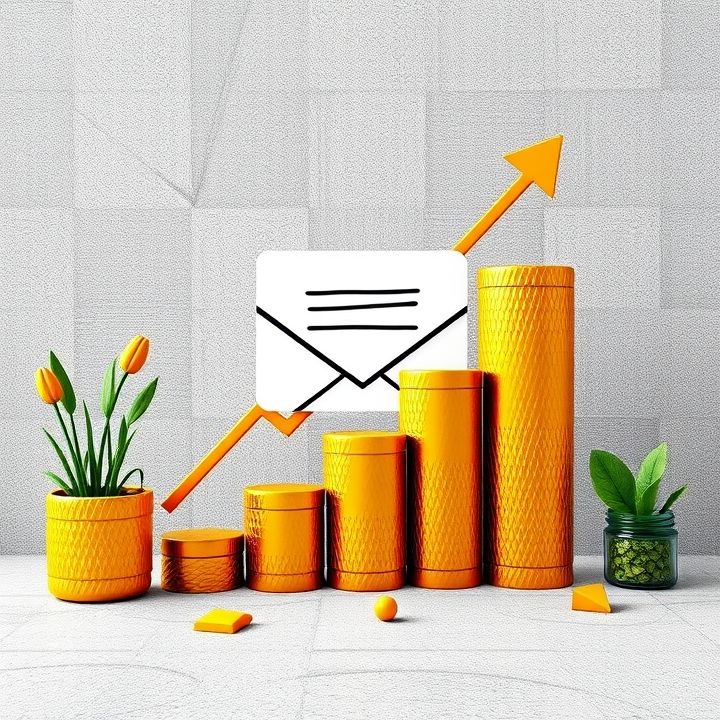Table of Contents
- Introduction
- Understanding Your Audience’s Needs
- Crafting Compelling Subject Lines
- Providing Useful and Relevant Content
- Personalizing Your Email Content
- Using Segmentation for Targeted Messaging
- Incorporating Clear and Direct Calls to Action
- Testing and Analyzing Email Performance
- Ensuring Mobile-Friendliness and Accessibility
- Conclusion
- Frequently Asked Questions
Introduction
In the fast-paced digital age, capturing your audience’s attention is more challenging than ever. The secret to standing out might just be in your inbox. How do you transform mere words into powerful connections that not only engage but also convert? Welcome to our guide on turning your email content into irresistible value bombs that subscribers simply cannot ignore!
The key lies in the intricate art of email marketing, where content meets creativity and analytics. If you’ve ever wondered why your email campaigns don’t get the traction they deserve, we have some incredible insights to share. Unleash a world where every word counts and every click leads to a deeper bond with your audience.
| Step | Action |
|---|---|
| 1 | Crafting the Perfect Subject Line |
| 2 | Personalizing Your Message |
| 3 | Engaging Call-to-Action |
Understanding Your Audience’s Needs
Understanding your audience’s needs is pivotal in crafting email content that resonates and provides value. The first step is to segment your audience based on demographics, interests, and behaviors. This allows for a more tailored approach, ensuring that the content addresses the specific needs and preferences of each group. Conducting surveys and gathering feedback are effective methods to gain insights into what your subscribers are seeking from your emails.
Analyzing past interactions with your emails, such as open rates and click-through rates, can also shed light on what content performs well and what topics are of interest. It’s crucial to listen actively to your audience’s feedback and adapt your content strategy accordingly. Creating personas can further aid in visualizing your audience’s needs, helping you to generate relevant content that sparks engagement.
Moreover, keeping abreast of industry trends and staying updated on any changes that might affect your audience allows you to provide timely and pertinent information. By aligning your email content with the evolving needs and expectations of your subscribers, you are more likely to foster loyalty and enhance the overall effectiveness of your email marketing campaigns.
Crafting Compelling Subject Lines
Crafting compelling subject lines is a crucial strategy for ensuring your email content is both valuable and engaging for subscribers. Subject lines are the first impression of your email, acting as a gateway to the content within. Therefore, they need to be attention-grabbing without being misleading. A great subject line should be concise, conveying the essence of your message in just a few words. Personalization can significantly enhance the appeal, as including the subscriber’s name or preferences can create a sense of connection.
In addition, employing a sense of urgency or exclusivity can motivate readers to open the email. Words like ‘limited-time offer’ or ‘exclusive access’ can pique interest and encourage prompt engagement. It’s also beneficial to intrigue curiosity by posing questions or highlighting compelling statistics. However, it’s important to maintain transparency and accurately reflect the content of the email to build trust over time.
Testing various subject lines through A/B testing can provide insights into what resonates most with your audience, allowing you to refine your approach continually. Ultimately, a well-crafted subject line serves as a powerful tool in enhancing the value of your email content, ensuring it stands out in crowded inboxes.
Providing Useful and Relevant Content
Providing useful and relevant content is key to maintaining a strong email marketing strategy. To ensure your subscribers find value in your emails, begin by understanding their needs and preferences. Segment your email list based on demographics, behaviors, or interests to tailor your content more precisely. This allows you to send personalized messages that resonate with different segments of your audience. Conduct surveys or polls to gather direct feedback on what your subscribers expect from your emails.
Utilize analytics tools to track the performance of your email campaigns. Analyzing metrics like open rates, click-through rates, and conversion rates helps identify what content appeals most to your subscribers. Adjust your strategies based on these insights to improve engagement. Additionally, staying updated with industry trends and news ensures you provide timely and relevant information, further establishing your brand as a credible source.
Make sure your emails are not just promotional but also educational or entertaining, providing value outside of direct sales. Deliver a balance of content that informs, engages, and occasionally promotes your products or services. This approach not only enhances the subscriber experience but also increases the likelihood of your subscribers eagerly anticipating future communications.
Personalizing Your Email Content
Personalizing your email content is a crucial strategy for ensuring that your communication is both valuable and engaging to subscribers. By tailoring emails to the individual preferences and needs of your audience, you enhance the likelihood of a positive response. Personalization goes beyond simply addressing the recipient by their first name. It involves crafting content that resonates with their interests, past interactions, and anticipated needs.
One effective way to achieve personalization is through segmenting your email list. Segmentation allows you to target specific groups based on demographics, purchase history, or engagement levels. For instance, sending product recommendations based on previous purchases makes the content relevant, increasing the chances of conversion and customer satisfaction.
Another method is using dynamic content, which adjusts the message based on the recipient’s profile. This could include offering location-specific deals or highlighting products related to browsing history. Furthermore, personalized subject lines can significantly boost open rates by immediately capturing the reader’s attention.
Incorporating behavior-triggered emails, such as follow-ups after a cart abandonment, not only personalizes the user experience but also nurtures the lead effectively. Overall, investing time in personalization reflects an understanding of your audience, fostering deeper connections and loyalty.
Using Segmentation for Targeted Messaging
One effective strategy for enhancing the value of your email content is segmentation for targeted messaging. Segmentation involves dividing your email list into distinct groups based on specific criteria such as demographics, interests, purchasing behavior, or engagement levels. By doing so, you can tailor your content to meet the specific needs and expectations of each segment, thereby increasing the relevance and impact of your messages.
For instance, you might create different campaigns for new subscribers versus long-term customers. New subscribers may benefit from introductory content or welcome offers, while loyal customers might appreciate updates on new products or exclusive deals. Behavioral segmentation, based on past interactions with your brand, allows you to send personalized recommendations or reminders to encourage repeat purchases.
Using segmentation ensures that your subscribers receive content that resonates with their unique preferences and stages in the customer journey, which can lead to higher engagement rates and improved customer satisfaction. Moreover, targeted messaging helps in building a deeper connection with your audience, enhancing brand loyalty over time. Therefore, investing in segmentation tools and strategies is crucial for crafting valuable and impactful email content.
Incorporating Clear and Direct Calls to Action
Incorporating clear and direct calls to action (CTAs) in your email content is crucial for guiding subscribers towards the desired outcome. A well-crafted CTA can significantly enhance engagement, drive conversions, and ensure your communications are effective. First, it’s essential that the CTA is prominently placed and visually distinct from the rest of the content, drawing the reader’s attention immediately. Use contrasting colors, bold fonts, or buttons to ensure it’s easily noticeable.
Additionally, the language of your CTA should be compelling yet simple. Use action-oriented words that create a sense of urgency or excitement, such as ‘Subscribe Now,’ ‘Get Started,’ or ‘Claim Your Discount.’ It’s also beneficial to personalize CTAs based on the subscriber’s previous interactions or interests, which can be determined through data analytics.
Furthermore, ensure that each email contains a single, clear CTA to avoid overwhelming the reader with too many choices. Align the CTA with the email’s overall objective to maintain coherence and relevance. Regularly testing different CTAs to find which resonates best with your audience can also enhance effectiveness. By strategically incorporating clear and direct calls to action, you’re not only making your emails more purposeful but also increasing the likelihood of engaging and converting your subscribers.
Testing and Analyzing Email Performance
Testing and analyzing email performance is crucial for crafting email content that resonates with your audience. This process begins with defining clear metrics, such as open rates, click-through rates, conversion rates, and unsubscribe rates. By focusing on these key performance indicators, you can gain insights into how your emails are being received.
A/B testing, also known as split testing, is an effective strategy to compare different versions of an email to determine which elements boost performance. You can experiment with subject lines, email copy, call-to-action buttons, and even sender names to see which variants your audience prefers.
After sending out your campaigns, utilize analytics tools to track performance. These tools provide valuable data on how recipients interact with your emails, allowing you to refine and enhance future campaigns.
It’s essential to analyze this feedback consistently, adapting your strategies according to what works and what doesn’t. This iterative process not only helps in improving engagement rates but also in understanding subscriber preferences, leading to more personalized and effective email content. By making data-driven decisions, you can ensure that your email campaigns are not just seen but also appreciated and acted upon by your subscribers.
Ensuring Mobile-Friendliness and Accessibility
Ensuring mobile-friendliness and accessibility in email content is crucial in today’s digital landscape. With a significant number of users accessing emails on mobile devices, it’s imperative that your emails are optimized for smaller screens. Start by using a responsive design that automatically adjusts the layout based on the device’s screen size. This ensures that the text is readable and the visuals are clear without requiring excessive scrolling or zooming.
Additionally, keep the email design simple and uncluttered, as complex designs may not render well on mobile devices. Ensure that buttons and links are large enough to be easily tapped, avoiding frustration for your subscribers. It’s also essential to test emails across various devices and email clients to guarantee a consistent experience for all users.
Accessibility should be a priority, making your email inclusive for users with disabilities. Use alt text for images so that screen readers can convey their message and structure your content with headers to facilitate navigation. Choose contrasting colors to enhance readability and consider using larger fonts for better visibility. By integrating these strategies, you enhance both mobile-friendliness and accessibility, providing a seamless and inclusive user experience for all subscribers.
Conclusion
In conclusion, transforming your email content into irresistible value bombs for subscribers requires a strategic approach and a keen understanding of your audience. By delving deep into your audience’s needs, crafting compelling subject lines, and ensuring the content is both useful and relevant, you can significantly enhance engagement. Personalization plays a pivotal role, as does segmentation, enabling you to tailor your messages for maximum impact. Incorporating clear and direct calls to action ensures that subscribers know exactly what to do next, boosting conversions. Testing and analyzing performance offers critical insights, allowing for constant refinement and optimization. Furthermore, ensuring mobile-friendliness and accessibility broadens your reach, making your emails more inclusive. By adopting these practices, you not only provide value but also foster a loyal subscriber base eager to engage with your communications. Ultimately, success hinges on your willingness to adapt and evolve with your audience, ensuring that every email sent is a step towards deeper connections and sustained engagement.

